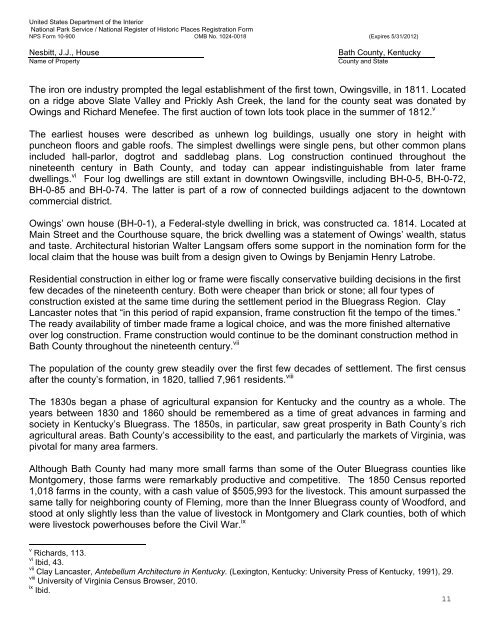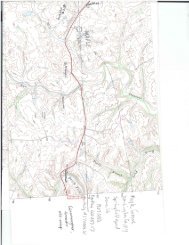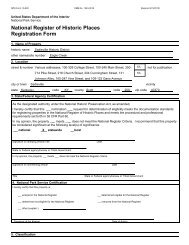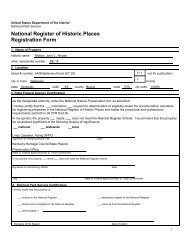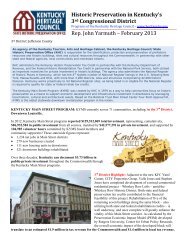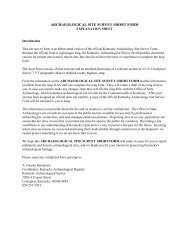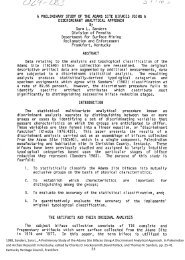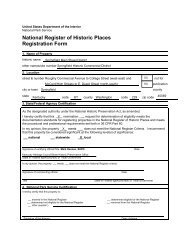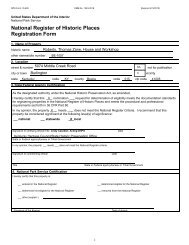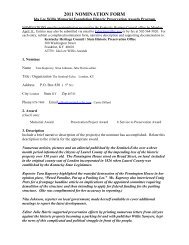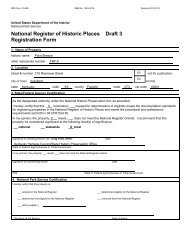JJ Nesbitt House - Kentucky: Heritage Council
JJ Nesbitt House - Kentucky: Heritage Council
JJ Nesbitt House - Kentucky: Heritage Council
You also want an ePaper? Increase the reach of your titles
YUMPU automatically turns print PDFs into web optimized ePapers that Google loves.
United States Department of the Interior<br />
National Park Service / National Register of Historic Places Registration Form<br />
NPS Form 10-900 OMB No. 1024-0018 (Expires 5/31/2012)<br />
<strong>Nesbitt</strong>, J.J., <strong>House</strong><br />
Name of Property<br />
Bath County, <strong>Kentucky</strong><br />
County and State<br />
The iron ore industry prompted the legal establishment of the first town, Owingsville, in 1811. Located<br />
on a ridge above Slate Valley and Prickly Ash Creek, the land for the county seat was donated by<br />
Owings and Richard Menefee. The first auction of town lots took place in the summer of 1812. v<br />
The earliest houses were described as unhewn log buildings, usually one story in height with<br />
puncheon floors and gable roofs. The simplest dwellings were single pens, but other common plans<br />
included hall-parlor, dogtrot and saddlebag plans. Log construction continued throughout the<br />
nineteenth century in Bath County, and today can appear indistinguishable from later frame<br />
dwellings. vi Four log dwellings are still extant in downtown Owingsville, including BH-0-5, BH-0-72,<br />
BH-0-85 and BH-0-74. The latter is part of a row of connected buildings adjacent to the downtown<br />
commercial district.<br />
Owings’ own house (BH-0-1), a Federal-style dwelling in brick, was constructed ca. 1814. Located at<br />
Main Street and the Courthouse square, the brick dwelling was a statement of Owings’ wealth, status<br />
and taste. Architectural historian Walter Langsam offers some support in the nomination form for the<br />
local claim that the house was built from a design given to Owings by Benjamin Henry Latrobe.<br />
Residential construction in either log or frame were fiscally conservative building decisions in the first<br />
few decades of the nineteenth century. Both were cheaper than brick or stone; all four types of<br />
construction existed at the same time during the settlement period in the Bluegrass Region. Clay<br />
Lancaster notes that “in this period of rapid expansion, frame construction fit the tempo of the times.”<br />
The ready availability of timber made frame a logical choice, and was the more finished alternative<br />
over log construction. Frame construction would continue to be the dominant construction method in<br />
Bath County throughout the nineteenth century. vii<br />
The population of the county grew steadily over the first few decades of settlement. The first census<br />
after the county’s formation, in 1820, tallied 7,961 residents. viii<br />
The 1830s began a phase of agricultural expansion for <strong>Kentucky</strong> and the country as a whole. The<br />
years between 1830 and 1860 should be remembered as a time of great advances in farming and<br />
society in <strong>Kentucky</strong>’s Bluegrass. The 1850s, in particular, saw great prosperity in Bath County’s rich<br />
agricultural areas. Bath County’s accessibility to the east, and particularly the markets of Virginia, was<br />
pivotal for many area farmers.<br />
Although Bath County had many more small farms than some of the Outer Bluegrass counties like<br />
Montgomery, those farms were remarkably productive and competitive. The 1850 Census reported<br />
1,018 farms in the county, with a cash value of $505,993 for the livestock. This amount surpassed the<br />
same tally for neighboring county of Fleming, more than the Inner Bluegrass county of Woodford, and<br />
stood at only slightly less than the value of livestock in Montgomery and Clark counties, both of which<br />
were livestock powerhouses before the Civil War. ix<br />
v Richards, 113.<br />
vi Ibid, 43.<br />
vii Clay Lancaster, Antebellum Architecture in <strong>Kentucky</strong>. (Lexington, <strong>Kentucky</strong>: University Press of <strong>Kentucky</strong>, 1991), 29.<br />
viii University of Virginia Census Browser, 2010.<br />
ix Ibid.<br />
11


